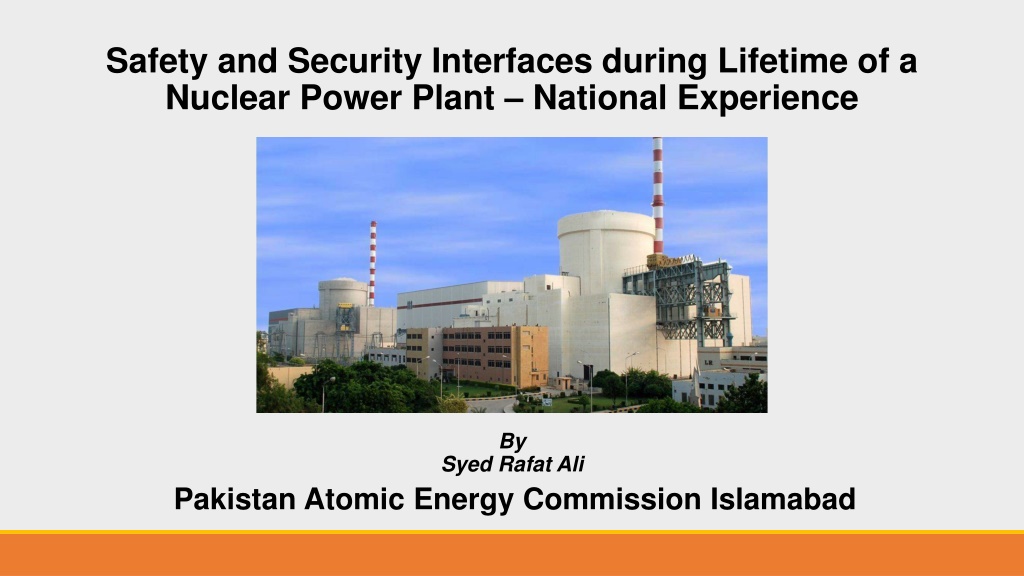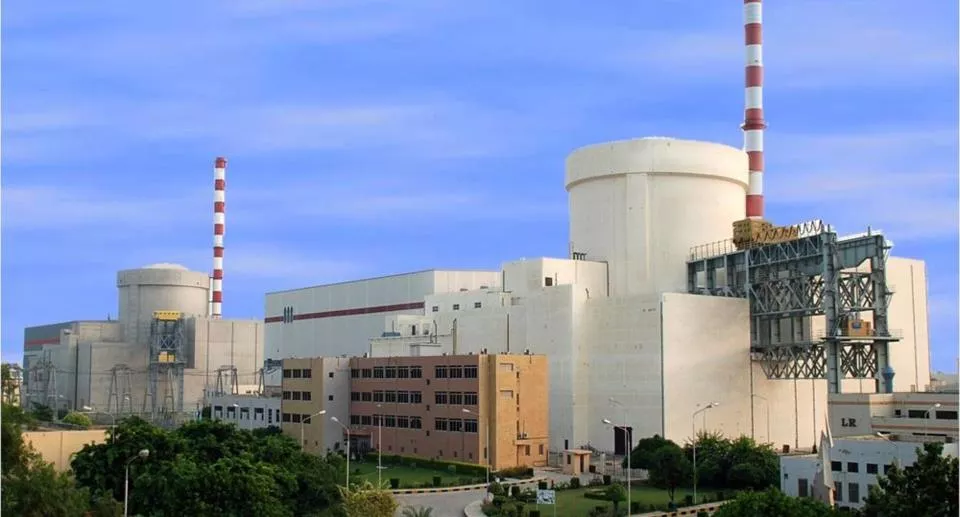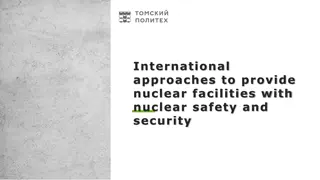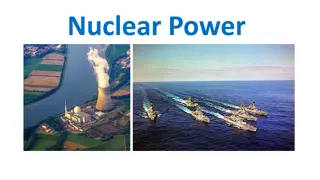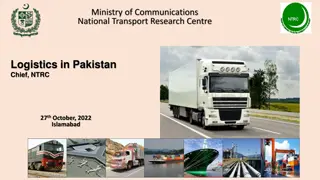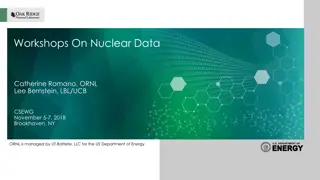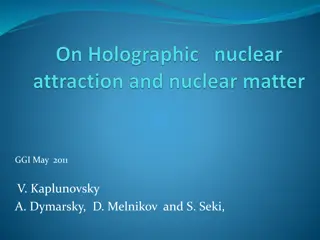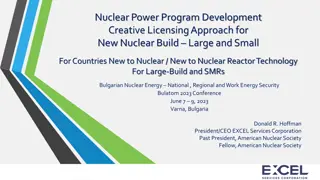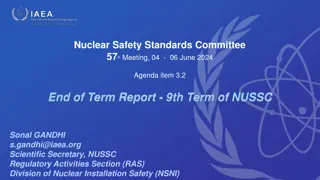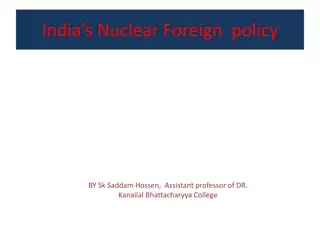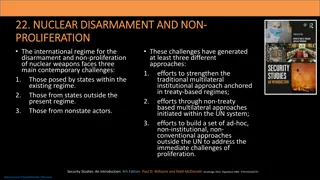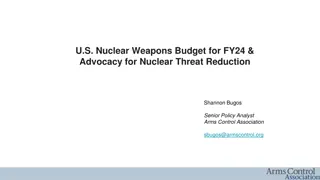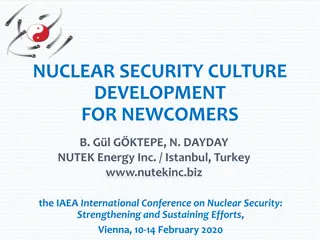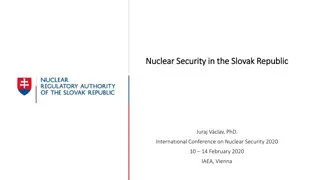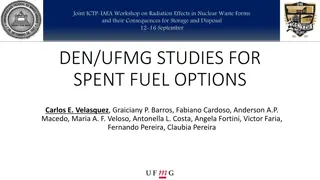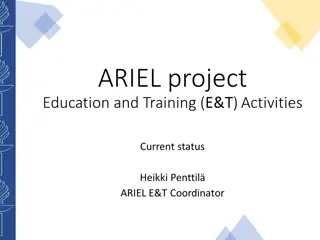Ensuring Safety and Security in Pakistan's Nuclear Power Sector
Pakistan's Nuclear Power Sector operates several nuclear power plants under strict safety and security protocols regulated by the Pakistan Atomic Energy Commission and the Pakistan Nuclear Regulatory Authority. The focus is on achieving nuclear safety to prevent accidents and protect workers and the environment, as well as ensuring nuclear security to prevent theft, sabotage, and unauthorized access to nuclear materials and facilities. The goal is to maintain robust safety-security synergy for the efficient operation of nuclear installations.
Download Presentation

Please find below an Image/Link to download the presentation.
The content on the website is provided AS IS for your information and personal use only. It may not be sold, licensed, or shared on other websites without obtaining consent from the author. Download presentation by click this link. If you encounter any issues during the download, it is possible that the publisher has removed the file from their server.
E N D
Presentation Transcript
Safety and Security Interfaces during Lifetime of a Nuclear Power Plant National Experience By Syed Rafat Ali Pakistan Atomic Energy Commission Islamabad
Presentation Outline Pakistan s Nuclear Power Sector Nuclear Safety and Nuclear Security National Safety and Security Regimes National Experience towards Safety of Nuclear Installations National Experience towards Security of Nuclear Installations Safety-Security Synergy at Nuclear Installations in Pakistan Conclusion 2
Pakistans Nuclear Power Sector In Pakistan, five nuclear power plants viz; C-1, C-2, C-3, C-4, and K-1 are operational under the umbrella of Pakistan Atomic Energy Commission (PAEC) and under the regulatory control of Pakistan Nuclear Regulatory Authority (PNRA) Two more power plants i.e. K-2 and K-3 are currently in construction phase Safety and Security is of utmost importance during the lifetime of these Nuclear Power Plants (NPPs). A great deal of challenges are, however, involved in the application of nuclear technology including safety, security and safeguards 3
Nuclear Safety and Nuclear Security Nuclear Safety The achievement of proper operating conditions, prevention of accidents or mitigation of accident consequences, resulting in protection of workers, the public and the environment from undue radiation hazards Nuclear Security The prevention and detection of, and response to, theft, sabotage, unauthorized access, illegal transfer or other malicious acts involving nuclear materials, other radioactive substances, or their associated facilities 4
Goal of Nuclear Safety Mitigation Emergency preparedness, response Control Safety Systems Prevention Design Accidents Natural disasters Workers Public Environment Malfunctions Component Failure Human Errors Unconscious Operator 5
Goal of Nuclear Security Mitigation: Response Measures Protection: Guarding, PPS Prevention: Facility Design Unauthorized Access Theft Workers Public Environment Diversion Sabotage Other Malicious Acts 6
Nuclear Safety and Nuclear Security Side by Side Prevention Prevention Protection Control Mitigation Mitigation Workers Public Environment Potential hazards From normal operation and accidents Potential Hazards from Malicious Acts 7
Safety and Security Regimes Nuclear safety and nuclear security regimes are based on a number of international legal instruments viz; Conventions Resolutions and Codes of conduct Pakistan is the party of Convention on Nuclear Safety as well as to the Convention on Physical Protection of Nuclear Material (CPPNM) and 2015 amendment PAEC has also implemented national regulations on safety and security during the lifetime of nuclear installation(s) 8
National Experience towards Safety of Nuclear Installations Nuclear Safety Policy Safety in Nuclear Power Plants Operation PAEC Corporate Safety Oversight Program 9
Nuclear Safety Policy Pakistan Atomic Energy Commission (PAEC) is the operator of Nuclear Power Plants in Pakistan. PAEC has national role in maintaining scientific & technological bases for safe use of nuclear energy. PAEC has formally established and implemented a Nuclear Safety Policy from which specific safety rules, procedures and other requirements are derived to ensure the safety of general public and workers. developing and 10
Safety in Nuclear Power Plants Operation In addition to national programs and committees (CAP, SAP, SPI etc.), international commission such as WANO and OSART also visit Pakistan, periodically, for conducting Peer reviews and pre-start up reviews. OSART WANO A Peer Review at K-1 (1994) Follow-up of Peer Review at K-1 (1996) A Peer Review Mission at C-2 (2015) A Review Mission at C-1 (2015) A Pre-Startup Mission at C-3 (2016) 11
PAEC Corporate Safety Oversight Program Directorate General of Safety (DOS), a corporate office of PAEC, is aimed to oversee the implementation of safety standards at NPPs through various directorates Directorate of Physical Protection and Emergency Management (PP&EM) oversee the physical protection of NPPs, radiological emergency preparedness and response plans. DOS has also established PAEC Emergency Response Coordination Center (PERCC) communicate among all stake holders, in the event of emergency which is responsible to 12
National Experience towards Security of Nuclear Installations Security in Design and Construction of NPPs Security in Operation of NPPs PAEC Corporate Security Oversight Program 13
Security in Design and Construction of NPPs During the design and construction phase(s) of K-2 and K-3, following security measures are incorporated: Nuclear security and Physical Protection (PP) is included in initial phases of siting, layout and design Design of Physical Protection System (PPS) are based on graded approach consistent with Nuclear Security Recommendations on Physical Protection of Nuclear Material and Nuclear Facilities (INFCIRC/225) and the concept of defense in depth is also incoroporated as per Amended CPPNM 14
Security in Operation of Nuclear Power Plants Following Physical Protection (PP) measures are taken at NPPs: At C-series, an integrated PPS is designed, implemented and maintained. A robust Central alarm Station (CAS) is established for monitoring and assessment of alarms and communication to response force. A Backup Alarm Station (BAS) is also established in case of unavailability of CAS At KANUPP, the concept of defense in depth is incorporated in design and installation of PPS. Adequate physical protection measures for access control, personnel search, vehicle search etc. are incorporated at various protection layers i.e. limited access area, protected area and core area 15
PAEC Corporate Security Oversight Program PAEC Corporate office, oversee the physical protection of NPPs and radiological emergency preparedness response The physical protection plans are reviewed under PAK/925 and PAK/926. As per national regulation (PAK/913), a physical protection plan must be in place before introduction of nuclear material in to the facility Physical Protection/Security drills are also conducted periodically and officials from corporate office also participate to observe and suggest Areas for Improvements (AFIs). 16
Safety-Security Synergy at Nuclear Installations in Pakistan Safety and security interfaces during the lifetime of NPPs in following areas: Establishment, implementation and maintenance of nuclear safety regime Establishment, implementation and maintenance of nuclear security regime Identification of areas where nuclear safety and security share similarities; Identification of areas where nuclear safety and security differ; Identification of safety concepts & operational practices to enhance protection Integration of safety and security measures such that implementation of one does not compromise the other; Awareness of safety and security synergy 17
Areas Where Nuclear Safety and Security Share Similarities Nuclear Safety and Security Share Similarities in various areas e.g. Placement of reactors inside containment structures To keep radiation from reaching the environment To provide a robust structure against terrorist attacks Controlled access to NPPs To ensure authorized access only Use of Electronic Pocket Dosimeter (EPD) to access containment building To ensure radiation protection and controlled access to vital area Synergy is achieved by interlocking the turnstile gate with EPD reader 18
Areas Where Nuclear Safety and Security Differ Nuclear safety and security differ in following areas: Access Control Safety ensures knowledge based movement Security requires need based movement Information sharing Safety requires information sharing for free and for all Security emphasizes on need to know principle Communication channel Safety establishes wide outreach for communication channels Security emphasizes on secure network 19
Safety Concepts And Operational Practices Which Enhance Protection Certain design criteria imposed for safety purposes may serve to reinforce security, e.g. Single failure criterion applied to safety systems requires the nuclear installation to be designed with a sufficient level of redundancy and/or diversification to ensure that safety functions are maintained Redundancy in safety design also serves as security layers against adversaries actions i.e. adversaries must compromise several safety layers in order to cause a radiological release Several layers of protection reinforce safety as the adversary needs to bye-pass these layers for accessing the safety systems/controls 20
Integration of Safety and Security Measures without Compromising Either One such example is emergency exit door having following features: Emergency exit doors are installed in vital/inner area so as to provide unhindered egress in case of emergency with push bars installed on secure/inner side only The doors are under surveillance in CAS through an integration software. In case of intrusion, CCTVs will automatically pop-up in CAS for the assessment of alarm The doors are designed and installed such that they enhance the intruder penetration time 21
Areas to Improve Synergy Following measures have been taken to improve synergy: Safety people are made aware of the security arrangements e.g. location of barriers, access points, secure channels Security personnel are provided with basic knowledge of safety e.g. TDS principle, targets locations and emergency services at NPPs Moreover, to improve synergy following actions are also taken: Plant operations review committee is made functional Work planning and control committee is made functional Design control and configuration management is in place Quality assurance audits are conducted periodically 22
Conclusion Nuclear Safety and Nuclear Security have common goals but different approaches and culture which must not be pitted against each other so as to avoid: Delays of scheduled activities Unintended security vulnerabilities Unintended impacts to safety systems Unintended impacts to emergency response activities Table talks and interface platforms should be promoted to share the commonalities and differences A common glossary of terminology should be developed covering the key concepts within each field 23
Thank You Thank You
